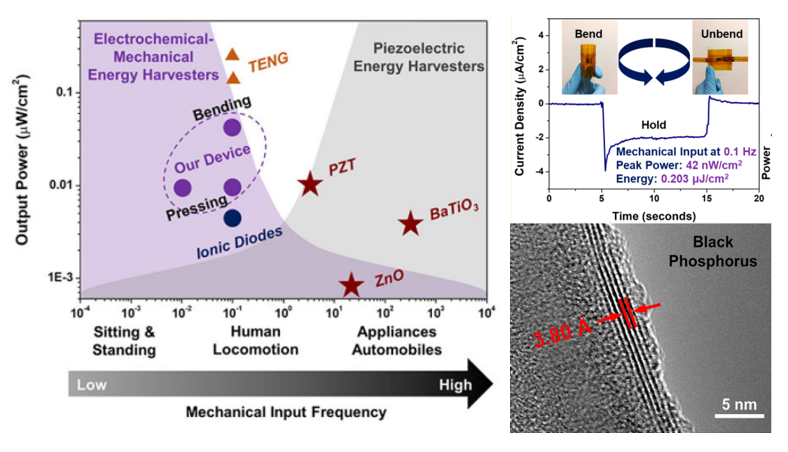Summary
Vanderbilt researchers have developed a novel energy-harvesting device capable of efficient electrochemical strain energy harvesting at frequencies as low as 0.01 Hz. The device enables the harvesting of energy produced from low frequencies associated with human motion such as walking and sitting.
Addressed Need
Conventional ambient mechanical energy harvesting systems are capable of capturing energy at high frequencies (> 10 Hz) produced by piezoelectric and triboelectric materials. However, their performance drastically drops at low frequencies (< 5 Hz), which is where virtually all human motion occurs. Consequently, it is impossible to efficiently leverage human motion for energy using current technology. The proposed device overcomes this with ultrathin materials that respond to small potential differences created during the mechanical bending and pressing motions of humans.
Technology Description
The mechanochemical strain harvester is comprised of two sodiated 2D black phosphorous nanosheets approximately 3 to 20 atomic layers thick. Two electrodes are produced by depositing each nanosheet onto a graphene and copper foil to create a bendable and conducting interface. The nanosheets are then stacked in a sandwich configuration, separated by a polypropylene separator. When the device is introduced to bending or pressing, it produces a stress gradient between the two electrodes. To reach an equilibrium potential on the electrodes, sodium ions migrate down the stress gradient across the separator, which is accompanied by the flow of electrons in the external circuit, producing a current flow. The current iteration of the device has a peak power delivery of ~42 nW/cm2 and total harvested energy of 0.203 μJ/cm2 in bending mode and ~9 nW/cm2 and 0.792 μJ/cm2 in pressing mode.
Commercial Applications
Potential applications of this technology include fabrics and clothing embedded with an energy harvesting system to power external devices, as well as other media for sensing, tracking, and analyzing human motions.
Technology Development Status
Proof of concept has been achieved and the device has been tested under biomechanical motions. Currently in development of fabrics and textiles impregnated with the device.
Intellectual Property Status:
Patent: US 11,588,418





